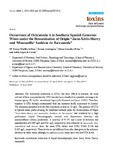Mostrar el registro sencillo del ítem
Occurrence of ochratoxin A in southern Spanish generous wines under the denomination of origin "Jerez-Xérès-Sherry and 'Manzanilla' Sanlúcar de Barrameda"
| dc.creator | Murillo Arbizu, María Teresa | es_ES |
| dc.creator | Amézqueta, Susana | es_ES |
| dc.creator | González-Peñas, Elena | es_ES |
| dc.creator | López de Cerain, Adela | es_ES |
| dc.date.accessioned | 2024-01-18T11:49:41Z | |
| dc.date.available | 2024-01-18T11:49:41Z | |
| dc.date.issued | 2010 | |
| dc.identifier.citation | Murillo-Arbizu, M. T., Amézqueta, S., González-Peñas, E., & De Cerain, A. L. (2010). Occurrence of ochratoxin a in southern spanish generous wines under the denomination of origin “Jerez-Xérès-Sherry and ‘Manzanilla’ Sanlúcar de Barrameda”. Toxins, 2(5), 1054-1064. https://doi.org/10.3390/toxins2051054 | en |
| dc.identifier.issn | 2072-6651 | |
| dc.identifier.uri | https://hdl.handle.net/2454/47089 | |
| dc.description.abstract | The mycotoxin ochratoxin A (OTA) has toxic effects in animals; the most relevant of them is nephrotoxicity. OTA has also been classified as a possible carcinogen for humans (group 2B) by the International Agency for Research on Cancer (IARC). Therefore, exposure to OTA through contaminated food can represent health impairment to humans. The maximum permitted level for this mycotoxin in wine is 2.0 g/L. The presence of OTA in Spanish wines produced using the traditional methods under the Denomination of Origin “Jerez-Xérès-Sherry and manzanilla Sanlúcar de Barrameda” was evaluated by a High performance Liquid Chromatography method with fluorescence detection and immunoaffinity column purification. A recovery of 95.4% and a limit of detection and quantification of 0.009 g/L and 0.02 g/L respectively, were achieved. In manzanilla, fino, amontillado and oloroso wine, the mean OTA values were 0.042, 0.044, 0.144, and 0.319 g/L, respectively. These levels are not different from other data given in the reference literature on white wines, although fino and manzanilla wines have very low OTA levels. | en |
| dc.description.sponsorship | M. Murillo-Arbizu and S. Amézqueta wish to thank the Department of Education of the Government of Navarra for the supporting grants. | en |
| dc.format.mimetype | application/pdf | en |
| dc.language.iso | eng | en |
| dc.publisher | MDPI | en |
| dc.relation.ispartof | Toxins, 2010, 2, 1054-1064 | en |
| dc.rights | © 2010 by the authors. Licensee MDPI, Basel, Switzerland. This article is an open access article distributed under the terms and conditions of the Creative Commons Attribution (CC BY) license. | en |
| dc.rights.uri | https://creativecommons.org/licenses/by/3.0/ | |
| dc.subject | Mycotoxins | en |
| dc.subject | Ochratoxin A | en |
| dc.subject | Liquid chromatography | en |
| dc.subject | Wine | en |
| dc.subject | Jerez | en |
| dc.subject | Xérès | en |
| dc.subject | Sherry | en |
| dc.subject | Manzanilla | en |
| dc.title | Occurrence of ochratoxin A in southern Spanish generous wines under the denomination of origin "Jerez-Xérès-Sherry and 'Manzanilla' Sanlúcar de Barrameda" | en |
| dc.type | Artículo / Artikulua | es |
| dc.type | info:eu-repo/semantics/article | en |
| dc.date.updated | 2024-01-18T11:38:53Z | |
| dc.contributor.department | Agronomía, Biotecnología y Alimentación | es_ES |
| dc.contributor.department | Agronomia, Bioteknologia eta Elikadura | eu |
| dc.rights.accessRights | Acceso abierto / Sarbide irekia | es |
| dc.rights.accessRights | info:eu-repo/semantics/openAccess | en |
| dc.identifier.doi | 10.3390/toxins2051054 | |
| dc.relation.publisherversion | https://doi.org/10.3390/toxins2051054 | |
| dc.type.version | Versión publicada / Argitaratu den bertsioa | es |
| dc.type.version | info:eu-repo/semantics/publishedVersion | en |
| dc.contributor.funder | Gobierno de Navarra / Nafarroako Gobernua | es |



